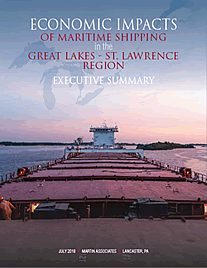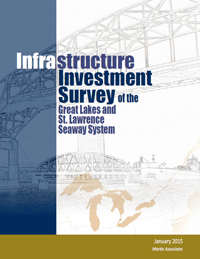Economic Impacts
The Economic Impacts of the Great Lakes - St. Lawrence Seaway System
Infrastructure Investment Survey of the Great Lakes and St. Lawrence Seaway System
The Economic Impacts of the Great Lakes - St. Lawrence Seaway System
From the earliest days of European settlement, the Great Lakes and St. Lawrence River have been utilized as a means of transportation. Great Lakes cities were founded as trading posts along a vast marine highway that facilitated commerce in an era pre-dating railroads and highways. This relationship to the water has enabled the region to thrive and today, the Great Lakes- St. Lawrence region is the industrial and agricultural heartland of both the United States and Canada – with a combined GDP of more than $6 trillion U.S. dollars. This output would represent the third-largest economy in the world – behind the U.S. and China – if it were a country.
Over the last 200 years, navigation improvements in both the United States and Canada have enhanced the waterway. The Welland Canal first connected Lake Ontario and Lake Erie in 1829, enabling vessels to bypass Niagara Falls. The Soo Locks have made the St. Marys River navigable, connecting Lake Superior to the lower four Great Lakes and the St. Lawrence Seaway. The St. Lawrence Seaway has tamed the St. Lawrence River, enabling ships to sail from Lake Ontario to the Atlantic Ocean since 1959.
The resulting deep-draft inland navigation system is the longest in the world, extending 3,700 kilometers (2,300 miles) into the North American heartland. This bi-national trade corridor complements the region’s rail and highway network and offers customers a cost-effective, safe, reliable and environmentally smart means of moving raw materials, agricultural commodities and manufactured products to and from domestic and global markets. Cargoes include iron ore, coal, steel, aluminum, machinery, stone, cement, grain, sugar, fertilizers, road salt, petroleum products and containerized goods. These cargoes become the staples of everyday life — food and other household items; buildings, factories, roads and bridges; vehicles and planes; and the energy that powers cities and towns.
Three distinct vessel-operator communities serve the waterway. These include U.S. domestic carriers (“U.S. Lakers”) transporting cargo between ports on the Great Lakes, Canadian domestic carriers (“Canadian Lakers”) operating between ports on the Great Lakes and the St. Lawrence River and Canadian coastal waters, and ocean-going vessel operators (“Salties”), which operate between the region’s ports and overseas destinations. These carriers serve more than 110 system ports located in each of the eight Great Lakes states and the provinces of Ontario and Quebec.
In addition to locks, ships and ports, a host of maritime service providers work to ensure the safe, reliable and efficient transport of cargo. These include stevedores, warehouse employees, freight forwarders, dockworkers, crane operators, vessel agents, dredging contractors, marine pilots, truck drivers and port rail operators, tugboat operators and shipyard workers.
Infrastructure Investment Survey of the Great Lakes and St. Lawrence Seaway System
The investment survey, compiled by maritime trade consultants Martin Associates, tallies CDN $7.1 billion in capital spending on ships, ports and terminals and waterway infrastructure in the Great Lakes-St. Lawrence waterway. More than $4.8 billion has been invested in the navigation system from 2009-2013 and another $2.3 billion is committed to improvements from 2014-2018.
Amongst the most significant investments, Canadian, American and international ship owners are spending $4.1 billion on the biggest renewal of the Great Lakes-St. Lawrence fleets in 30 years. The Canadian and U.S. federal governments, through respectively The St. Lawrence Seaway Management Corporation and the Saint Lawrence Seaway Development Corporation, have dedicated close to $1 billion to modernize the Seaway’s lock infrastructure and technology over the 10-year period — the Seaway’s most significant transformation in five decades. And Great Lakes and St. Lawrence River ports and terminals are also collectively investing more than $1.8 billion on expanding their docks, equipment, facilities and intermodal connections.



